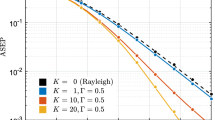Abstract
The nature of a wireless communication channel is very unpredictable. To design a good communication link, it is required to know the statistical model of the channel accurately. The average symbol error probability (ASER) was analyzed for different modulation schemes. A unified analytical framework was presented to obtain closed-form solutions for calculating the ASER of M-ary differential phase-shift keying (M-DPSK), coherent M-ary phase-shift keying (M-PSK), and quadrature amplitude modulation (QAM) over single or multiple Nakagami-m fading channels. Moreover, the ASER was estimated and evaluated by using the maximal ratio-combining (MRC) diversity technique. Simulation results show that an error rate of the fading channel typically depends on Nakagami parameters (m), space diversity (N), and symbol rate (M). A comparison between M-PSK, M-DPSK, and M-QAM modulation schemes was shown, and the results prove that M-ary QAM (M-QAM) demonstrates better performance compared to M-DPSK and M-PSK under all fading and non-fading conditions.
Similar content being viewed by others
References
MAAREF A, AISSA S. Exact error probability analysis of rectangular QAM for single- and multichannel reception in nakagami-m fading channels [J]. IEEE Transactions on Communications, 2009, 57(1): 214–221.
JACOBS L, MOENECLAEY M. Exact BER analysis for QAM transmission on arbitrary fading channels with maximal-ratio combining and imperfect channel estimation [C]// IEEE 19th International Symposium on Personal, Indoor and Mobile Radio Communications. Cannes, France: IEEE, 2008: 1–5.
YAO M, JINGHUA J. Effect of channel estimation errors on M-QAM with MRC and EGC in Nakagami fading channels [J]. IEEE Transactions on Vehicular Technology 2007, 56(3): 1239–1250.
CHARASH U. Reception through Nakagami fading multipath channels with random delays [J]. IEEE Transactions on Communication, 1979, 27(4): 657–670.
KARAGIANNIDIS G K, SAGIAS N C, MATHIOPOULOS T. The N *Nakagami fading channel model [C]// International Symposium on Wireless Communication Systems. Siena, Italy: IEEE, 2005: 185–189.
TURIN G, CLAPP F, JOHNSTON T, FINE S, LAVRY D. A statistical model of urban multipath propagation [J]. IEEE Transactions on Vehicular Technology, 1972, 21(1): 1–9.
FOTHOHABAD V, SAID F. Comparison of the rayleigh and Nakagami fading channels MIMO multicarrier system [C]// Conference on Wireless Advanced. London, UK: IEEE, 2011: 295–300.
JUANG M, PARSLEY M B. New results on finite-state Markov models for Nakagami fading channels [C]// Conference on Military Communication. Baltimore: IEEE, 2011: 453–458.
PATTERH M S, KAMAL T S, SOHI B S. Performance of coherent square M-QAM with Lth order diversity in Nakagami-m fading environment [C]// IEEE Conference on Vehicular Technology. Boston, USA: IEEE VTS, 2000: 2849–2853.
GRADSHTEYN I S, RYZHIK I M. Table of integrals, series, and products [M]. USA: Academic Press, 2007: 346.
ALOUINI M S, GOLDSMITH A J. A unified approach for calculating error rates of linearly modulated signals over generalized fading channels [J]. IEEE Transaction on Communication, 1999, 47(9): 1324–1334.
SEO S, LEE C, KANG S. Exact performance analysis of M-ary QAM with MRC diversity in Ricean fading channels [J]. Electronics Letters, 2004, 40(3): 485–486.
PROAKIS G J, SALEHI M. Digital communications [M]. New York: McGraw-Hill Inc., 2001: 233–320.
CHIANI M, DARDARI D. Improved exponential bounds and approximation for the Q-function with application to average error probability computation [C]// IEEE Global Telecommunications Conference. Taipei, Taiwan: IEEE, 2002: 1399–1402.
Author information
Authors and Affiliations
Corresponding author
Additional information
Foundation item: Project supported by Research Fund Chosun University 2014, Korea
Rights and permissions
About this article
Cite this article
Alam, A.S.M.S., GoangSeog, C. Performance of M-QAM, M-DPSK and M-PSK with MRC diversity in a Nakagami-m fading channel. J. Cent. South Univ. 21, 1347–1352 (2014). https://doi.org/10.1007/s11771-014-2072-7
Received:
Accepted:
Published:
Issue Date:
DOI: https://doi.org/10.1007/s11771-014-2072-7




